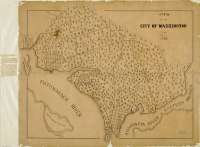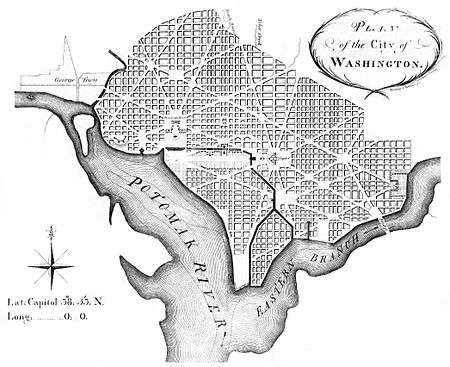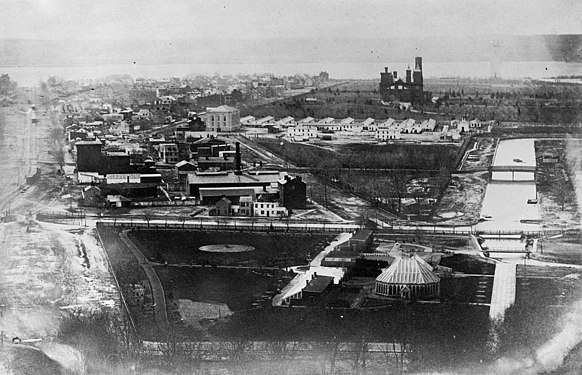Washington City Canal
The Washington City Canal (or simply the Canal as it was known in the city) operated from 1815 until the mid-1850s in Washington, D.C. The canal connected the Anacostia River, called the "Eastern Branch" at that time, to Tiber Creek, the Potomac River, and later the Chesapeake and Ohio Canal (C&O). The canal fell into disuse in the late 19th century and the city government covered over or filled in various sections in 1871.
| Washington City Canal | |
|---|---|
_showing_the_Washington_City_Canal.png) Washington City Canal in 1851 | |
| Specifications | |
| Status | Underground under Constitution Avenue |
| History | |
| Date of first use | 1815 |
| Date closed | 1871 |
Built in 1837,[1] the canal's Lockkeeper's House remains today — at what is now the southwest corner of 17th Street, and Constitution Avenue, Northwest, Washington, D.C., near Constitution Gardens — as the oldest building on the National Mall.[1][2]
History
Early planning and development

View of the City of Washington in 1792, showing Goose Creek (Tiber Creek) and James Creek (18??)
.jpg)
Facsimile of manuscript of Peter Charles L'Enfant's 1791 plan for the federal capital city (U.S. Coast and Geodetic Survey, 1887).[3]

L'Enfant Plan as revised by Andrew Ellicott incorporating the Canal
In the early years of the United States there was great interest among political leaders in building canals to support and stimulate economic development. Construction of a canal to run across the city of Washington was supported by local leaders, both in business and government.[4] The plan was to connect the Eastern Branch, which was navigable into Maryland, with the Potomac, which was seen as a gateway to the West. President George Washington had founded the Potowmack Company in 1785 to improve navigation on the Potomac.
Pierre (Peter) Charles L'Enfant, in designing a master plan for the development of the capital city, supported construction of a canal between the Eastern Branch and Tiber Creek.[5] To raise funds for canal construction, lotteries were conducted in 1796, but these efforts were unsuccessful. There was little additional work done until 1802, when Congress granted a charter for the Washington Canal Company. A small amount of construction was started, but obtaining major financing for the canal continued to be difficult.
Congress created a new canal company in 1809 and authorized capitalization of $100,000. A groundbreaking ceremony in southeast Washington, attended by President James Madison and other officials, took place on May 2, 1810. Construction was delayed by the War of 1812 and resumed in 1815.
Canal opening and operation


The canal formally opened in late 1815.[6] The canal route began at the Eastern Branch, near the Washington Navy Yard and proceeded north and northwest. Another planned branch proceeded north and northeast from the estuary of James Creek, which divided Greenleaf Point from Buzzard Point but was only constructed in 1866 and never connected with the existing canal.[7] Past the point at which these two branches were planned to converge, a single canal channel travelled north towards the Capitol, veered northwestward at the base of Jenkins Hill (Capitol Hill), and then turned again to the north to cross the area in which the National Mall is now located. The canal then turned sharply to the west, joining a straightened and channelized Tiber Creek, which had earlier flowed westward. After traveling westward along the route of Tiber Creek, the canal entered the Potomac River at the mouth of the creek, which was south of the White House.
As originally built, the Washington City Canal was shallow and only accommodated boats drawing 3 feet of water or less. The canal's design did not adequately handle tidal variations on the Eastern Branch. As a result, the canal sometimes overran its banks at high tide, and/or experienced insufficient water levels at low tide. Traffic through the canal continued but financial problems persisted, and in 1831 the city purchased the canal corporation. The city effected some repairs during the 1830s and Congress appropriated some additional funds in 1833.
Also in 1833, an extension of the C&O Canal was completed. That extension, designated as the Washington Branch of the C&O Canal, enabled the C&O Canal to connect at a new eastern terminus with the western terminus of the Washington City canal at the mouth of Tiber Creek.[8][9][10] A lock was built to connect the two canals, and around 1835, a lock keeper's house was built. The lock keeper's house now stands at the southwest corner of Constitution Avenue NW and 17th Street NW, near the National Mall.[11][12]
In 1849, Congress appropriated some additional funds to clean out and deepen portions of the canal, on the condition that the city provide matching funds. The city made some improvements to the canal, but it experienced problems with contractors and staff, and the planned work was not completed in the 1850s. During this period, with the increasing development of railroads, interest in canals waned among both business and government leaders.
Decline

By the late 1850s, the Washington City Canal had fallen into disuse, as had the Washington branch of the C&O Canal. During the Civil War years the canal deteriorated further and was serving as both a sewer and storm drain system for the central part of the city. Various proposals were circulated to either rehabilitate the city canal or fill it in. Congress appropriated some funds in 1866, but no work was done at that time. In 1871, Alexander "Boss" Shepherd, the city's head of Public Works, directed that the Tiber Creek portion of the canal be covered over. This work was accomplished over many years, along with other drainage alterations in the central city. A new street that was constructed over this portion of the canal was initially designated as B Street NW. The street was later renamed to Constitution Avenue NW.
The southern portion of the Washington City Canal remained open for years afterwards, but eventually was also paved over. The section between South Capitol and New Jersey was filled in in the late 1870s's and the section east of that in the early 1880s. The section east of South Capitol was filled in gradually between 1928 and 1930. A street constructed south of the Capitol over that section of the canal now connects Independence Avenue, Southwest, and E Street, Southeast. Formerly designated as Canal Street, the northernmost section of the street was later renamed to Washington Avenue in commemoration of the state of Washington.[13]
Today, the streams flowing under the city in the sewers is often referred to as Tiber Creek though its common past with the Canal is acknowledged.[14]
See also
Notes
- Talia Wiener (July 5, 2018). "181-Year-Old Lockkeeper's Tiny House Ready For Its Next Chapter". NPR.
- "Why is there a Lockkeepers House on the Mall?". Mallhistory.org.
- L'Enfant, Peter Charles; United States Coast and Geodetic Survey; United States Commissioner of Public Buildings (1887). "Plan of the city intended for the permanent seat of the government of t(he) United States: projected agreeable to the direction of the President of the United States, in pursuance of an act of Congress passed the sixteenth day of July, MDCCXC, "establishing the permanent seat on the bank of the Potowmac": [Washington, D.C.]". Washington: United States Coast and Geodetic Survey. LCCN 88694201. Retrieved 2017-03-05. Facsimile of the 1791 L'Enfant plan in Repository of the Library of Congress Geography and Map Division, Washington, D.C.
- Law, Thomas (1804). "Observations on the Intended Canal in Washington City". Records of the Columbia Historical Society, Washington, D.C. 8: 159.
- L'Enfant identified himself as "Peter Charles L'Enfant" during most of his life, while residing in the United States. He wrote this name on his "Plan of the city intended for the permanent seat of the government of t(he) United States ...." (Washington, D.C.) and on other legal documents. However, during the early 1900s, a French ambassador to the U.S., Jean Jules Jusserand, popularized the use of L'Enfant's birth name, "Pierre Charles L'Enfant". (Reference: Bowling, Kenneth R (2002). Peter Charles L'Enfant: vision, honor, and male friendship in the early American Republic. George Washington University, Washington, D.C. ISBN 978-0-9727611-0-9). The United States Code states in 40 U.S.C. § 3309: "(a) In General.—The purposes of this chapter shall be carried out in the District of Columbia as nearly as may be practicable in harmony with the plan of Peter Charles L'Enfant." The National Park Service identifies L'Enfant as "Major Peter Charles L'Enfant" and as "Major Pierre (Peter) Charles L'Enfant" on its website.
- Bryan, Wilhelmus Bogart (1916). A History of the National Capital from Its Foundation Through the Period of the Adoption of the Organic Act, Volume 2. New York: MacMillan. p. 104. Retrieved 2009-10-08.
- United States Geological Survey topographic map with locations of Greenleaf Point and Buzzard Point in website of TopoQuest. Retrieved 2009-11-17; Wetzel, "Buzzard Point".
- ""The Canal Connection" marker". Historical Marker Database. Retrieved 2011-03-02.
- "Washington City Canal: Plaque beside the Lockkeeper's House marking the former location of in Washington, D.C." dcMemorials.com. Retrieved 2011-03-02.
- ""The Washington City Canal" marker". Historical Marker Database. Retrieved 2011-03-02.
- ""Lock Keeper's House" marker". Historical Marker Database. Retrieved 2011-03-02.
- Coordinates of lock keeper's house: 38.8919305°N 77.0397498°W.
- Coordinates of Canal Street: 38.885304°N 77.011145°W
- Kelly, John (2013-08-28). "What you'd see in Washington's Tiber Creek sewer—if you dared to go". The Washington Post.
References
| Wikimedia Commons has media related to Washington City Canal. |
- Heine, Cornelius W. (1953). "The Washington City Canal". Records of the Columbia Historical Society. 53-56: 1–27. JSTOR 40067664. Now called Historical Society of Washington, D.C.
- Wetzel, Hayden M., "Buzzard Point, DC: A Brief History of a Brief Neighborhood". Privately printed, Washington DC. 2014.